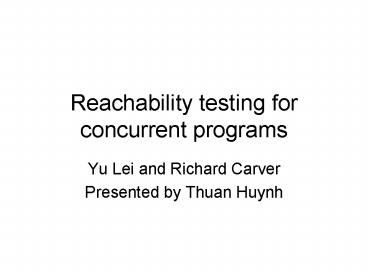Reachability testing for concurrent programs - PowerPoint PPT Presentation
1 / 22
Title:
Reachability testing for concurrent programs
Description:
Reachability testing for concurrent programs. Yu Lei and Richard Carver. Presented by Thuan Huynh ... Easy but inefficient, problems may appear at only extreme ... – PowerPoint PPT presentation
Number of Views:39
Avg rating:3.0/5.0
Title: Reachability testing for concurrent programs
1
Reachability testing for concurrent programs
- Yu Lei and Richard Carver
- Presented by Thuan Huynh
2
Overview
- Introduction
- Some existing tools
- Reachability testing
- Concepts
- Algorithm
- Implementation
- Optimizations
- Results
- Conclusion
3
Concurrent programs
- Multiple non-independent executions
- Multithreaded programs
- Distributed programs
- Very difficult to test
- Non deterministic interleavings/irreproducible
- Difficult to breakdown because problems come from
interactions
Thread1 Thread2
Thread3 t.send(1) t.send(2)
x t.recv()
y t.recv()
print x - y
4
Approaches to testing
- Deterministic testing
- Run all possible interleavings (how?)
- Select a subset of interleavings and force
execution to follow - Non-deterministic testing
- Run repeatedly for some time
- Easy but inefficient, problems may appear at only
extreme conditions at customers computers - Prefix-based testing
- Run test deterministically at the beginning
- Follow by nondeterminstic runs
5
Model checking/SPIN
- Use a modeling language PROMELA
- Explore all possible states of a program
- Support full LTL logic
- Suffer state explosion problem
- Partial order reduction to relieve the problem
- Use for very critical portion of software
- Verify network protocols
6
Java PathFinder
- Formal verification tool developed by NASA Ames
Research center - A more easier to use SPIN
- Explore ALL possible execution paths of a java
program without recompling - Also visit all possible states of the program
- Check every state for violations of assertions/
/properties/exceptions/deadlocks/livelock - Has a lot of heuristics and optimization to work
with big programs. - VeriSoft for C/C
7
Concutest-junit
- A concurrency-aware version of junit developed at
Rice University - Improvements
- Catch errors in auxiliary threads
- Have new invariants to check threading related
problems - Can insert delays at critical places
- Can record and playback specific interleavings
8
ConTest
- A tool to test concurrent java programs developed
by IBM Haifa Research Lab - Works without recompiling/new test
- Instruments existing bytecode
- Inserts heuristic sleep() and yield()
instructions to expose problems - Run multiple times
9
Reachability testing(prefix-based testing)
- Concepts
- Algorithm
- Implementations
- Optimizations
- Results
10
SYN-sequence
- We only care about the order of operations whose
interleavings has effect on execution - Sending/receiving data with another thread
- Semaphore/Monitors
- General execution model send/receive
- SYN-sequence sequence of synchronization events
- Aim execute all possible SYN-sequences
11
Happen-before relation
- Gives us the order of events, usually partial.
- We can extract these relations by watching an
execution - The unordered events are subjected to testing
- Why vector clock butnot single global clock?
a
b
?
x
c
d
?
e
f
12
Partial order reduction
s3
s1
b1
a
a
b
a
b1
a
b
bn
s2
bn
a
s4
13
Algorithm (RichTest)
- Run and collect a SYN-sequence s
- S ? s
- Repeat
- Get a sequence s ? S
- Runs each variant of s to collect sequences s1,
s2, sm - S ? s1, s2,, sm
- Until S empty
14
Example
Thread 1 Thread 2 Thread 3
Thread 4 P2.send(a) xp2.recv()
up3.recv() p2.send(b)
yp2.recv() vp3.recv() p3.send(d)
p3.send(c)
s2
r1
s1
r2
r3
s3
s4
r4
15
More concepts
- Race condition A receive() operation may match
with different send()s - Race_set(r) all send events that can possibly be
matched with the receive operation r
16
Race table
- Contains one column for each receive event r that
has a - nonempty race_set(r). The numbers in each row
represent - -1 remove r
- 0 no change
- 1..race_set(r) match r to the ith send in
race_set(r)
17
Example
Thread 1 Thread 2 Thread 3
Thread 4 P2.send(a) xp2.recv()
up3.recv() p2.send(b)
yp2.recv() vp3.recv() p3.send(d)
p3.send(c)
r1 r3
0 1
1 0
1 1
s2
r1
s1
race_set(r1) s1,s2
race_set(r3) s3,s4
r2
r3
s3
s4
r4
18
Implementation
- Library of synchronization objects semaphores,
monitors, send, receive - Control/record the execution using the library
- No modification to thread scheduler
- Portable to other operating systems and languages
19
Optimization
- Aim Do not visit a SYN-sequence twice
- Keeping a list of visited SYN-sequence is
expensive - Trick only include variants that obeys a
specific set of rules. Proven that - We can still visit all SYN-sequences
- Can start from any SYN-sequence
- Computationally inexpensive to check
20
Results
21
Results
22
Conclusion
- The new method for reachability testing
- Guarantees the execution of every SYN-seqence
exactly once - Does not require keeping a list of all visited
SYN-sequences - Outperforms existing partial order reduction
based techniques - Is platform independent































